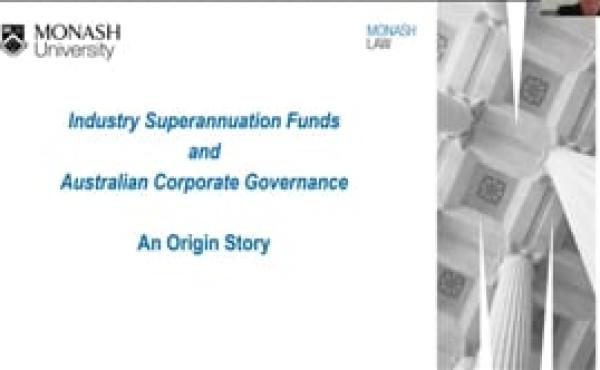Corporate Governance in Australia


CORPORATE GOVERNANCE AND INVESTOR STEWARDSHIP IN AUSTRALIA
Corporate governance in Australia is shaped by an evolved framework of legal rules, ‘soft-law’, and market expectations. The principal components of Australia’s corporate governance framework are outlined below.
Common law and statute
Australian companies are established under a federal statute: the Corporations Act 2001 (Corporations Act). The Corporations Act and the common law contain various rules which regulate the internal affairs of companies. This includes rules relating to the nature and form of a company’s constituent documents, the roles and powers of the board of directors and the shareholders, shareholder meetings, and shareholder remedies.
Several features of the Corporations Act are particularly significant from a corporate governance perspective. For instance, the legislation provides public company shareholders with mandatory rights to initiate and vote on amendments to their company’s constitution, remove directors without cause, and have an annual, non-binding ‘say on pay’. Subject to filing thresholds, shareholders can requisition or call shareholder meetings, and table voting proposals which must be circulated at the company’s expense.
Directors owe duties of loyalty and care to their company under common law. These duties can be enforced by the company or, subject to strict conditions, by shareholders pursuant to a derivative action regulated by the Corporations Act. The Corporations Act also imposes duties of care and loyalty on directors; the content of these duties is similar to the common law duties. The Corporations Act provides directors with a business judgement defence to a breach of duty of care claim; however, the defence is subject to strict pre-conditions and has been invoked successfully only in a small number of cases.
Significantly, directors’ statutory duties can be enforced by the Australian regulator, the Australian Securities and Investments Commission (ASIC). Much recent case law in Australia regarding directors’ duties has resulted from ASIC enforcement action, rather than from private litigation by companies or shareholders.
Company Constitutions
Under Australian law, a company’s constituent document can take the form of a written constitution, default rules set out in the Corporations Act, or a combination thereof. Stock exchange listing rules require publicly-traded companies to adopt a written constitution. These documents address the details of a company’s internal governance, such as the powers of a company’s board, the appointment of directors, and procedures for board and shareholder meetings. There is a significant degree of standardisation in the content of public company constitutions.
Under the Corporations Act, shareholders have a mandatory right to amend their company’s constitution by passing a resolution which is approved by at least 75 percent of the votes cast on it. Shareholders who meet filing thresholds in the Corporations Act can table amendment proposals without the consent of their company’s board.
Listing Rules and Corporate Governance Recommendations of the Australian Securities Exchange
The Australian Securities Exchange (ASX) is the principal securities exchange for listed equities in Australia. Companies listed on the ASX must comply with listing rules issued by the ASX (ASX Listing Rules). The ASX Listing Rules supplement the Corporations Act and common law rules in some important respects, including by imposing a one share-one vote requirement, regulating further issues of securities by listed entities, requiring shareholder approval for certain significant transactions, subjecting listed companies to continuous and periodic disclosure requirements, and imposing requirements regarding the convening and conduct of shareholder meetings.
The ASX Listing Rules take effect as a contract between a publicly-traded company and the ASX. In addition, the Corporations Act allows ASIC and persons aggrieved by any instance of non-compliance to apply to the court to have the ASX Listing Rules enforced against a listed entity and its associates.
Following high-profile corporate collapses in the early 2000s, the ASX established the ASX Corporate Governance Council, which consists of representatives of the business and finance community. Since 2003, the Council has issued and periodically updated a code of corporate governance recommendations for companies listed on the ASX. In 2019, the Council issued the fourth edition of the Corporate Governance Principles and Recommendations (ASX Governance Code).
The ASX Governance Code operates on an ‘if not, why not’ basis. That is, the ASX Listing Rules require listed entities to report annually on the extent to which they follow the recommendations in the code. If a listed entity does not follow a recommendation, it must identify that fact in its report and explain why.
The ASX Governance Code contains 38 recommendations. They include recommendations addressing director independence, the constitution and role of board committees, the separation of the roles of chair and CEO, executive remuneration, workforce diversity, codes of conduct and internal policies, and the conduct of shareholder meetings. A notable feature of the current edition of the code is that it includes new recommendations regarding corporate culture and values, and the management and disclosure of ESG-related risks.
Investor Guidelines and Expectations
Australia has highs levels of institutional ownership and, as a result, institutional investors have come to play a prominent role in Australian corporate governance. Owing to Australia’s mandatory retirement savings scheme, superannuation (pension) funds, in particular, have become significant investors in listed equities and are prominent in articulating and promoting expectations regarding companies’ corporate governance practices.
The peak representative bodies for asset owners and asset managers in Australia publish their expectations regarding companies’ corporate governance practices. A number of individual institutional investors also issue their own publications. Moreover, there is a significant industry of proxy advisers, engagement firms and governance advisers which facilitates institutional investors’ share voting and engagement activities. A number of these firms also issue publications outlining their expectations regarding companies’ corporate governance practices.
Institutional Investor Stewardship
The concept of institutional investor stewardship is well-recognised in Australia. To date, stewardship has been an industry-led initiative. Australia has, in fact, two stewardship codes: one issued by the peak representative body for asset managers (the Financial Services Council) and one issued by the peak representative body for asset owners (the Australian Council of Superannuation Investors).
The two codes adopt a non-prescriptive approach towards stewardship; that is, they operate on a ‘comply or explain’ approach and do not prescribe in detail the types of stewardship activities investors are expected to undertake. Nonetheless, it is generally acknowledged in Australia that institutional investors have significantly increased their participation in corporate governance since the 1990s. In particular, investors now proactively exercise their voting rights and engage in significant levels of behind-the-scenes interactions (or ‘engagement’) with companies. As a result, investors have been able to encourage meaningful changes in companies’ corporate governance practices.
Last updated: September, 2020
--------------
Contact:
Tim Bowley
Faculty of Law, Monash University
Melbourne, Australia
tim.bowley@monash.edu
--------------
Resources:
Corporate Governance Principles and Recommendations (4th ed)
FSC Stewardship Code [scroll down to Standard No. 23]
ECGI Working Paper by Tim Bowley and Jennifer Hill on Stewardship and Collective Action





















